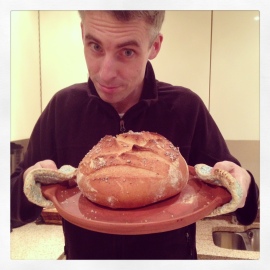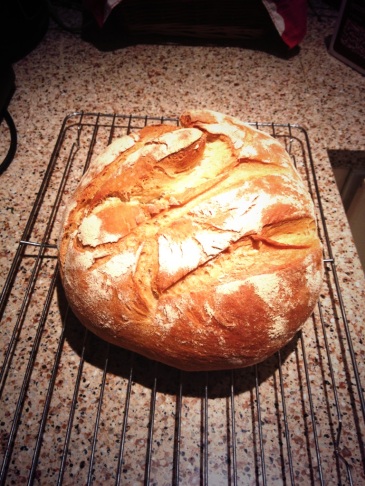WHAT can you do today that your very primitive ancestors did 30,000 years ago?
Apart from the obvious I mean, the scavenging, breathing, procreating, and running from predators stuff.
Very little, really. Stare at the sunset. Complain about the rain. That’s about it.
And make bread.
Yes, pounding out dough in your 21st century kitchen provides a direct link to the palaeolithic hunter gatherers who first made flatbreads in Europe during the late Stone Age.
They did it by grinding roasted cereal grains, mixing this flour with water and cooking it.
It’s a simple skill but one which I myself managed to avoid for most of my 30-something years.
Then, three or more years ago, I famously promised my wife that I’d bake us bread. It took me a while but I eventually got my hands sticky in recent weeks.
If a hunter-gatherer could do it using stone tools how hard could it be?
And so I found myself, 1,400 generations on from those first breadmakers, standing in my kitchen slamming and kneading dough.
Unlike late Stone Age man I had the advantage of yeast – and a very simple recipe for Hugh Fearnley-Whittingstall’s country white loaf.
Measure, mix, knead, proof, knead, proof, bake. Do it using five ingredients: flour, water, yeast, olive oil and salt.
And wait. Baking involves waiting, I quickly learned. Which involves patience. Which probably explains why it took me 30-odd years to get round to the practice (and enjoy it).
_____
Bread making was a skill somewhat lost to my generation. While my grandmother baked two loaves a day, and my mother a store of bread for the week on each Sunday of my youth, I never tried it.
Nor did many of my contemporaries. There were few, if any, loaves produced among my friends as I grew up and older.
Demands, usually of time but equally of inclination, ensured that bread was usually something that came from an aisle, not a bakery. The loaf gave way to the sliced pan.
So what changed?
A few years ago I embarked on mountaineering trips to France and Switzerland – a practice fuelled by husks of hardened, often week-old bread, carried in a backpack and softened in hot soup.
The durability and utility of these simple loaves stayed with me (unlike the taste, a unique flavour produced by five or six days rest in the bottom of a rucksack).
Shortly afterwards I met my wife and my diet changed in a few ways – one of which was her insistence on the sourcing of good bread (usually from Il Valentino or Arun Bakery).
Making my own was a logical next step.
_____
Writing during the Second World War the American food scribe M.F.K. Fisher lamented the then-fading practice of bread making at home.
Her call to (floury) arms is worth reading 70 years later:
“Breadmaking does not cost much. It is pleasant: one of those almost hypnotic businesses, like a dance from some ancient ceremony…
“But it takes a lot of time. If you can find that, the rest is easy. And if you cannot rightly find it, make it, for probably there is no chiropractic treatment, no Yoga exercise, no hour of meditation in a music-throbbing chapel, that will leave you emptier of bad thoughts than this homely ceremony of making bread.”
Except, maybe, eating it.


